Schneider WDE002939 Handleiding
Schneider
Thermostaat
WDE002939
Bekijk gratis de handleiding van Schneider WDE002939 (46 pagina’s), behorend tot de categorie Thermostaat. Deze gids werd als nuttig beoordeeld door 61 mensen en kreeg gemiddeld 4.7 sterren uit 31 reviews. Heb je een vraag over Schneider WDE002939 of wil je andere gebruikers van dit product iets vragen? Stel een vraag
Pagina 1/46

© 2011 Schneider Electric 1
Multi-function application with RTR and FanCoil 1816/1.0
Function overview
This application provides you with the following func-
tions:
• Temperature control with various display options
• Scene function
• Disable function for push-buttons
• Time control
• Valve control
• Push-button functions
All buttons can be assigned different functions inde-
pendently. You can do the following:
• Switch and toggle
• Dim
• Control blinds
• Save and retrieve scenes
• Select a linear regulator function
• Save edge functions
• Adjust setpoints
• Access operation modes and toggle between them
The status LEDs can also be utilised independently of
one another and in a wide variety of ways.
Group addresses
Group addresses are managed dynamically. Maximum
number of group addresses and assignments: 254 ad-
dresses, 255 connections
Notes on this documentation
This application enables you to implement a multitude
of functions with the push-button. However, which func-
tions are possible in each individual case depends on
the KNX devices being controlled (e.g. dimming actua-
tors, switch actuators etc.). The functions described
here therefore show only the settings for this push-but-
ton.
|Many parameters and their settings are depend-
ent on the settings you have already made for oth-
er parameters. This means that some parameters
will appear or disappear and the values available
for selection will change according to settings you
have already made. These dependencies have
not been shown in the table for reasons of clarity.
All settings are always shown.
|Configurable times (staircase timer, ON delay,
OFF delay, cyclic intervals etc.) are set via the
base and factor parameters. The actual time is giv-
en by the multiplication of the two values. Exam-
ple: Base = 1 second * factor = 3 gives 3 seconds.
|The bold values in a table are the values set dur-
ing factory configuration.
Before you begin, make a few basic settings in the
"General" tab. You can specify the following:
• Whether the operational LED switches off or displays
that the device is operating.
• How the date and time are received.
• Whether and how the time is sent cyclically to the bus.
• How large the start-up delay for the device should be
after bus voltage recovery.
General settings for date and time
Here you set whether the date and time are received by
two communication objects (3 byte each) or by only one
communication object. In the latter case, there is an 8
byte object available.
If you send the time cyclically to the bus, you either have
an output object with 3 byte or one with 8 byte, depend-
ing on which format you selected.
You can find more details on time control, synchronisa-
tion and master-slave functions in the "Time control"
chapter.
Start-up delay
The start-up delay is the time delay between the bus
voltage recovery and the device's functional start. Set a
time after which the current values can be read by other
KNX devices.
Communication objects
You can select the following communication objects:
Multi-function application with RTR and
FanCoil 1816/1.0
Basic settings
General
Parameter Settings
Switch on operational LED Yes
No
Receive date and time In one communication object
In two communication objects
Send time cyclically No
Every minute
Every hour
Daily
Format of sent time Date/time format (8 byte)
Time format (3 byte)
Device's start-up delay in s (0-255) 2-255, 4
Function Object name Type Prio Flags Behaviour
Time control Date object input 3 byte Low WC Receive
Time control Time object input 3 byte Low WC Receive
Time control Date/time object
input
8 byte Low WC Receive
Time control Date/time object
output
8 byte Low CT Transmit
Time control Time object out-
put
3 byte Low CT Transmit

2 © 2011 Schneider Electric
Multi-function application with RTR and FanCoil 1816/1.0
Here, you set the display options and display functions:
• You can disable the control menu so that the menu
buttons cannot be used to make further changes to
the settings.
• You use the display mode to specify which values you
want to display on the basic display (actual tempera-
ture, setpoint temperature, time, date, external tem-
perature and fan speed). You can display these
values either individually or in alternation. You can
also set the display rhythm for alternating displays.
The display mode can also be set using the control
menu on the push-button.
• For the weekday display, you can set day "1". This
means that the first weekday can be defined as: Fri-
day, Saturday, Sunday or Monday. Each weekday is
then shown in the display with a different number ac-
cordingly.
• Time format and unit of temperature display (Celsius/
Fahrenheit).
• The background lighting on the display can either be
switched off or on at all times, or can be switched on
during operation. You can also set the persistence pe-
riod and the brightness of the background lighting.
|The parameters for the background illumination
and display mode can be changed using the menu
buttons on the push-button (see operating instruc-
tions).
If you use room temperature control ("Control general"
tab), additional possible settings appear:
• You can specify whether or not the operation mode
can be changed when the frost or heat protection op-
eration mode is activated.
• "Access menu setpoint temperature/operation mode
directly" Here, you specify which operation mode you
want to select with a short push of a button on the
menu buttons. You can choose between the control
menu "Set setpoint temperature" or "Set operation
mode".
• On the display, a symbol can show either the current
controller status or whether heating or cooling is acti-
vated.
Setting the display Display heating and cooling symbol = shows current control-
ler status
Display Type of control
Heating active, correcting variable ≠0
Cooling active, correcting variable ≠0
1 2
(below the
symbols)
1 = Heating/cooling active, correcting variable ≠0
For two-stage heating/cooling
1 = Basic level active, correcting variable ≠0
2 = Basic level and additional level active, correcting
variable ≠0
-- Insensitive zone, correcting variables = 0
Display heating and cooling symbol = shows heating/cool-
ing
Display Type of control
Heating
Cooling
1 2
(below the
symbols)
1 = Heating/cooling active, correcting variable ≠0
For two-stage heating/cooling:
1 = Basic level active, correcting variable ≠0
2 = Basic level and additional level active, correcting
variable ≠0
Display
Parameter Settings
User menu enabled Yes
No
Adjust operation mode during
frost / heat protection
Yes
No
Set display mode (multiple names
appear during the change)
Actual temperature
Setpoint temperature
External temperature
Date
Time
Fan speed
Date/time
Date, time, fan speed
Actual temperature, setpoint tem-
perature
Actual temperature, setpoint tem-
perature, time
Actual temperature, setpoint tem-
perature, fan speed
External temperature, actual tem-
perature
External temperature, actual tem-
perature, time
Actual temperature, setpoint tem-
perature, time
Actual temperature, setpoint tem-
perature, fan speed, time
External temperature, actual tem-
perature, fan speed, time

© 2011 Schneider Electric 3
Multi-function application with RTR and FanCoil 1816/1.0
The signal function enables the device to display
whether the actual temperature is above or below a pre-
set value. The signal is shown on the display by the bell
symbol, and is ended when the actual temperature re-
turns to within the set range.
When an signal is issued, a "1" is transmitted to the bus
via the "Signal object output", and a "0" is transmitted
after the signal is finished. The "Signal object input" can
also be set to "1" by another sensor.
|The signal cannot be acknowledged. It is not pos-
sible to acknowledge the signal when the alarm is
triggered via the feedback object.
Communication objects
You can select the following communication objects:
On the “Push-button info” tab you can see which push-
button names in ETS correspond to which push-but-
tons on the device. The names assigned cannot be
changed.
Display rhythm 3 s - 10 s, 5 s
Time display 00:00 ...23:59
01:00 ...12:59 (AM/PM)
Access menu setpoint tempera-
ture/operation mode directly
(menu buttons)
No
Setpoint adjustment
Operation mode changed
Display heating and cooling sym-
bol
Shows the current controller sta-
tus
Shows heating/cooling
Unit of temperature display °C, °F
Display "1" corresponds to Friday
Saturday
Sunday
Monday
Switch on background lighting No
Yes
During operation + persist-
ence
Persistence period in s (1-254) 1-254, 10
Set brightness
(1 = very dark / 10 = very bright)
1-10, 5
Display
Parameter Settings
Use signal function
Signal function
Parameter Settings
Use signal function Yes
No
Report if actual temperature is higher than 20,0 = 68.0 °F to
40.0 °C = 104.0 °F,
No
Report if actual temperature is lower than 0,0 = 32,0 °F to
19,0 °C = 166.2 °F,
No
Function Object name Type Prio Flags Behaviour
Signal
function
Feedback object
input
1 bit Low WC Receive
Signal
function
Feedback object
output
1 bit Low CT Transmit
Push-button information
Push-button info
Parameter
Push-button 1 = Upper left push-button
Push-button 2 = Upper right push-button
Push-button 3 = Lower left push-button
Push-button 4 = Lower right push-button
Left menu button = Left push-button next to display
Right menu button = Right push-button next to display
Product specificaties
| Merk: | Schneider |
| Categorie: | Thermostaat |
| Model: | WDE002939 |
Heb je hulp nodig?
Als je hulp nodig hebt met Schneider WDE002939 stel dan hieronder een vraag en andere gebruikers zullen je antwoorden
Handleiding Thermostaat Schneider

30 Mei 2023

8 Mei 2023

2 Mei 2023

5 Maart 2023

22 Januari 2023

16 Januari 2023

13 Januari 2023

18 December 2022
Handleiding Thermostaat
- Wolf
- Elektrobock
- MundoControl
- Oreg
- Vemer
- Theben
- Sinustec
- Z-Wave
- Maginon
- Netatmo
- Tado
- Eneco
- De Dietrich
- Rose LM
- Tesla
Nieuwste handleidingen voor Thermostaat
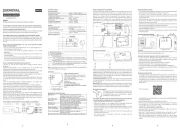
31 Juli 2025
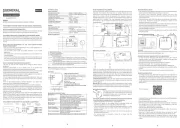
30 Juli 2025
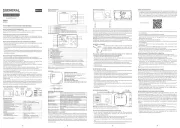
29 Juli 2025
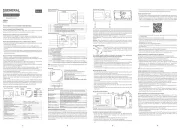
29 Juli 2025
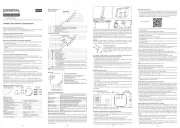
28 Juli 2025
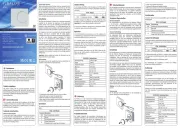
28 Juli 2025
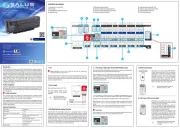
28 Juli 2025
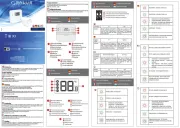
28 Juli 2025
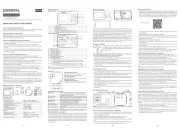
28 Juli 2025
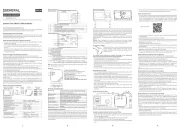
28 Juli 2025